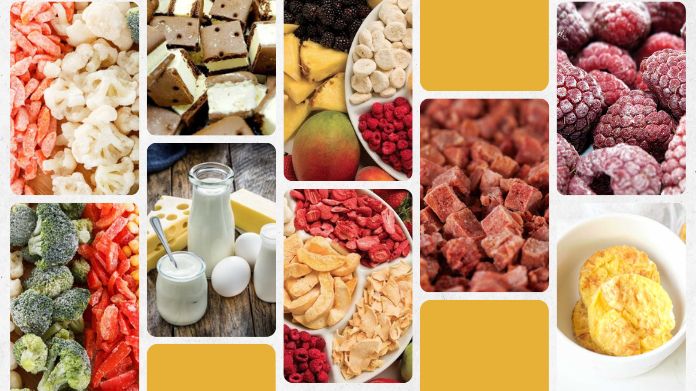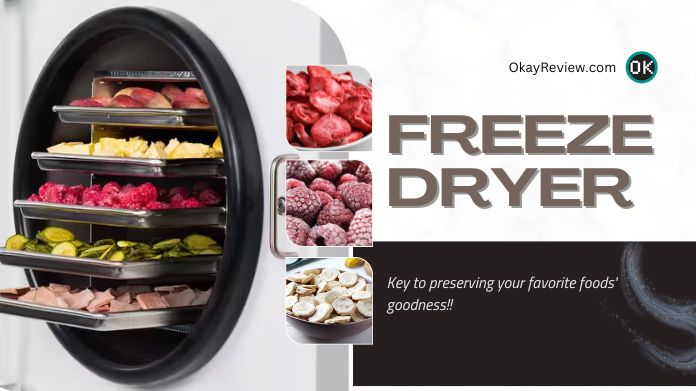In a world where the battle between taste and health often feels like an eternal struggle, a silent hero works his magic behind the scenes – the freeze dryer.
It’s the art of preserving meals while keeping them nutritious and delectable. But how does this freeze dryer’s magic operate, and are the resultant meals as nutritious as they are convenient?
Let’s take a trip through the icy world🧊 of freeze dryers, where we’ll uncover the mysteries of this food preservation process and separate the crisp truths from the frigid fallacies regarding its healthiness.
If you’re interested in preserving the goodness of food, you might also be interested in our best picks for salad spinners to make your culinary experiences even more delightful.
Table of Contents
What Exactly is Freeze-drying?
Freeze-drying, or lyophilization in the culinary world, is like Mother Nature’s stop button for your favorite delicious foods. It is the ultimate food preservation method, preserving everything from nutrients to tastes.
The product is frozen at extremely low temperatures and placed in a vacuum atmosphere throughout this procedure.
The frozen water in the product sublimates in the vacuum, converting straight from a solid (ice) to vapor without passing through the liquid phase.
This mild drying technique preserves the product’s original flavor, color, texture, and nutritional content while increasing its shelf life.
Consequently, a lightweight, shelf-stable product that can be rehydrated as needed is created, making it perfect for meals, medications, and other applications.
To eat healthier, consider including nutritious freeze-dried fruits and vegetables. You can also use them in delectable recipes like our Boston Roll Sushi.
How Does Freeze Dryer Work?
A freeze dryer is a culinary hero with a freezer obsession. It all starts with freezing your favorite treats to keep their superheroic structure.
Then, it transports them to a vacuum room where magic occurs. Water rebels in this low-pressure wonderland, transitioning from ice to vapor with no bothersome liquid phase in between.
It’s like witnessing a superhero evaporate into thin air, leaving behind only their suit. But hold on, there’s more!
Like a superhero returning from an interdimensional adventure, the moisture is collected and condensed, ready to rescue the day once more.
The result? Your treasured ingredients are turned into lightweight, shelf-stable replicas of themselves, entirely stored and ready to rehydrate anytime the world requires a culinary hero.
Are Freeze-Dried Foods Healthy?
Absolutely, freeze-dried foods are pantry superheroes, saving us from dull meals and unpleasant snacks. It’s like a summer burst in your mouth.
But, behind the taste explosion, there’s some science at work. Freeze dryer preserves those key elements, providing health advantages without sacrificing flavor.
It’s not all rainbows and sunshine in the world of freeze-dried foods. Some cunning people may smuggle in sweets, fake flavors, or preservatives.
But don’t worry, fellow foodies, since you can make sensible decisions. In the epic gourmet journey, freeze-dried sweets are your dependable buddy, ready to save your taste buds and nutrition objectives.
What Are the Foods That Can Be Freeze-dried?
 Freeze-drying is a culinary magic trick that transforms everyday dishes into light, long-lasting pleasures.
Freeze-drying is a culinary magic trick that transforms everyday dishes into light, long-lasting pleasures.
So, what exactly is in the wizard’s recipe book? A lot! Here are some examples of freeze-dried foods:
1. Fruits:
- Apples
- Strawberries
- Bananas
- Blueberries
- Pineapples
- Mangoes
- Raspberries
- Peaches
2. Vegetables:
- Peas
- Corn
- Carrots
- Bell peppers
- Broccoli
- Potatoes
- Onions
- Tomatoes
3. Meats:
- Beef
- Chicken
- Pork
- Turkey
- Fish (e.g., salmon, tuna)
- Shrimp
4. Dairy Products:
- Milk (for powdered milk)
- Cheese
- Yogurt (for powdered yogurt)
5. Soups and Stews:
- Various soups and stews can be freeze-dried, making them convenient for backpacking and emergency preparedness.
6. Eggs:
- Whole eggs or just egg whites can be freeze-dried for use in recipes.
7. Desserts and Sweets:
- Ice cream
- Pudding
- Cake
- Candy
- Marshmallows
Is It Possible to Freeze-dry Meals at Home?
Absolutely, let’s inject some levity and humanity into the home freeze-drying procedure while keeping it simple.
- Prepare the Food: Begin with the food that you wish to freeze-dry. Check that it is clean and, if required, well cooked.
- Cut into Small Pieces: Cut the meal into tiny, uniform pieces. Large portions of food should be avoided since smaller parts freeze-dry more effectively.
- Arrange on a Tray: Arrange the sliced food in a single layer on a tray. Check that they are not touching or overlapping one another; this enables efficient freezing.
- Freeze: Place the tray in the freezer at home. This stage demands patience because it takes about a week for the goods to freeze-dry properly using this procedure. The objective is to freeze the food.
- Test for Completion: Remove a piece of freeze-dried food from the freezer and let it defrost after about a week. Could you take note of how its hue changes? The freeze-drying process is complete when it returns to its natural or normal hue. However, if the food becomes black or dark brown when thawed, it hasn’t been thoroughly freeze-dried, and you may need to put it in the freezer for longer.
- Store Properly: Once your food has been effectively freeze-dried, keep it in airtight containers to preserve its quality and prevent moisture from re-entering the food. Proper storing will keep your freeze-dried meals shelf-stable for an extended time.
Our Thoughts
Freeze dryer is the unsung hero of food preservation, silently performing its magic behind the scenes.
Freeze-drying is a culinary superhero, from maintaining the crunch in your strawberries to ensuring your beef jerky is always ready for adventure.
So, as you dive into your hoard of freeze-dried treats, realize that every crispy mouthful is a monument to brilliant science and a nod to the fact that heroes don’t always wear capes.
Enjoy your freeze-dried feasts, fellow food explorers!

